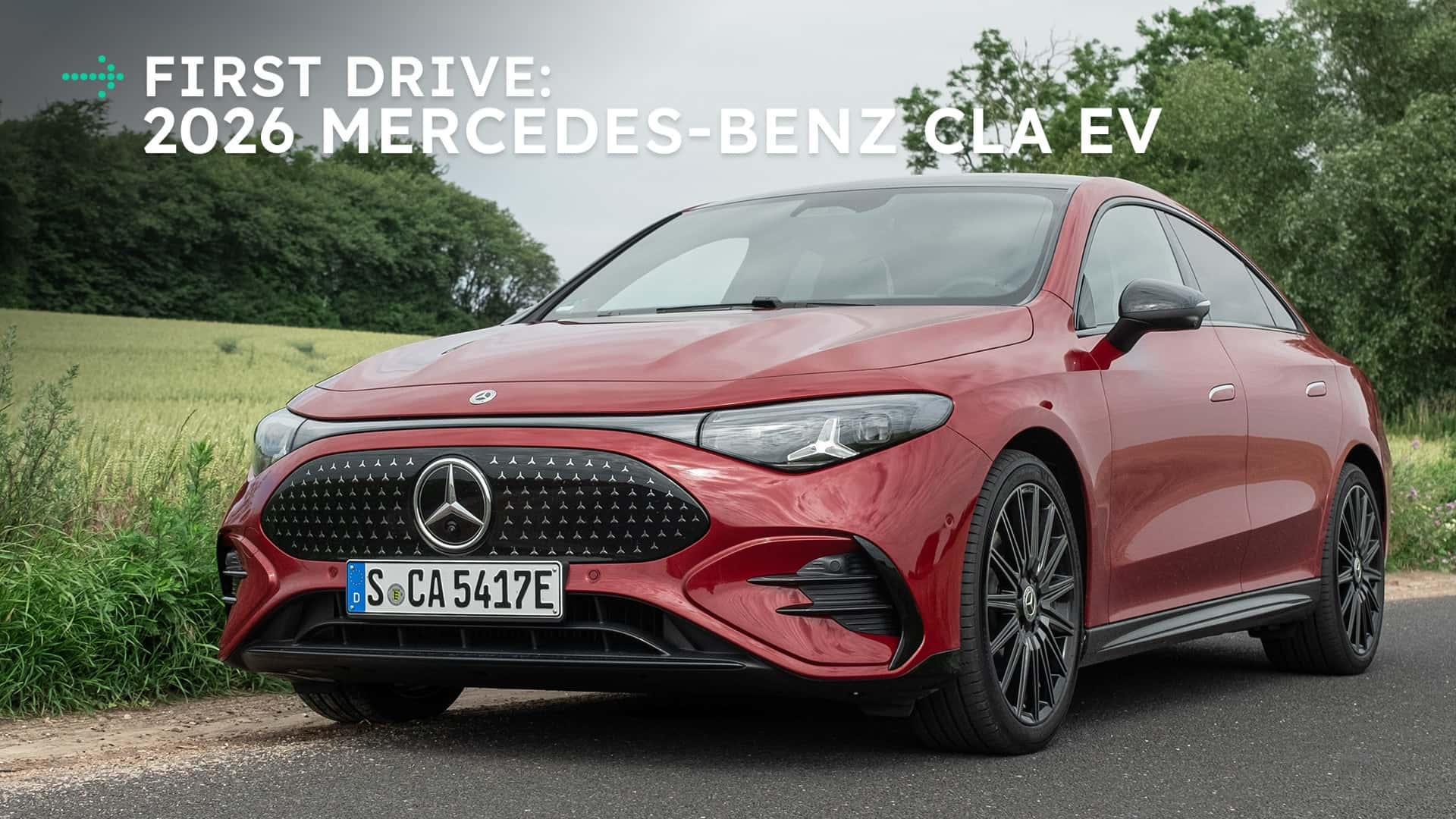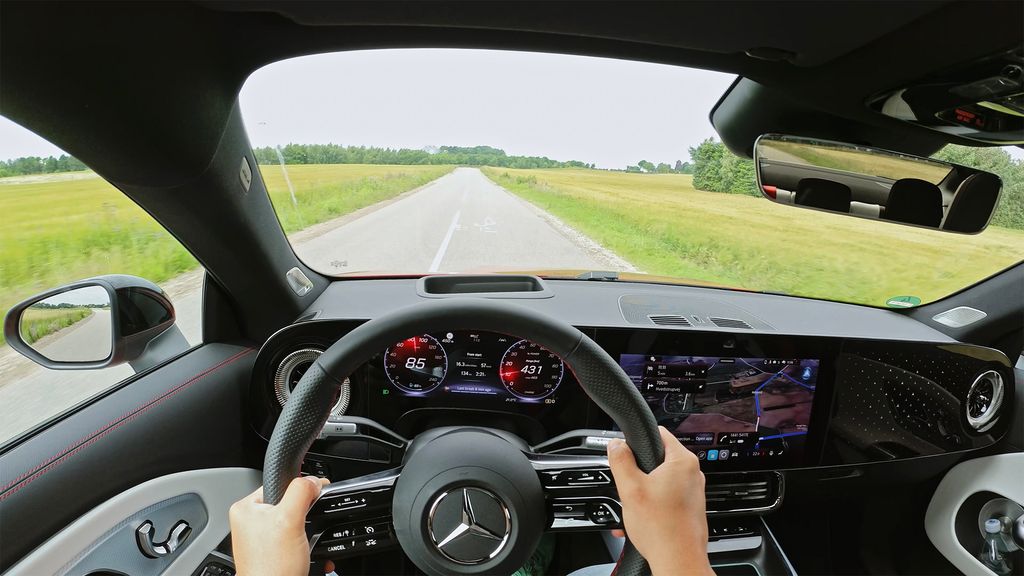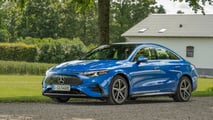
Mercedes-Benz is gearing up to launch an all-new, third-generation of its small, streamlined sedan, the CLA. But this is more than just a redesign of the entry-level model. It's a hugely important electric model for Mercedes, serving as the debut model for 800-volt EV architecture and its first software-defined vehicle (SDV), with a hybrid version also available.
Essentially, it's Mercedes's attempt to address all of the issues with its early approach to EVs. The leap into a true software-defined vehicle architecture is huge, too, as it adopts the approach of companies like Tesla, Rivian, BYD and countless Chinese brands. SDVs are upgradeable over the air, offer slick technology, and simplified electrical architectures that make them easier to build.
SDVs are basically computers on wheels, vehicles whose code is more important than their mechanical components. This approach makes some very feature-rich Chinese cars uninspiring to drive, but that thankfully isn’t the case with the new CLA. It also looks good in person, a benefit of Mercedes dropping the jellybean shapes and the "EQ" names. With a premium-feeling interior and incredible range and efficiency figures, the CLA is the automaker's best effort yet. But is that good enough?
Quick And Sorted

Mercedes had eight CLAs for journalists to try in Denmark, but only two of them were the dual-motor CLA 350 4Matic, which gets a combined power output of 349 horsepower, allowing it to sprint to 62 mph (100 km/h) in 4.9 seconds. I didn’t get a chance to get behind the wheel of a 350, but I did try two different 250+ examples, which were quite good.
The CLA 250+ gets a single 268-hp motor on the rear axle, allowing it to complete the benchmark sprint in 6.7 seconds. It feels about that quick from behind the wheel, although it’s not particularly exciting in a straight line.
With its larger 85 kilowatt-hour NMC battery pack (there will also be a smaller, lighter 58 kWh LFP battery), the CLA 250+ weighs a considerable 4,530 lbs (2,055 kg), while the dual-motor pushes that up to 4,706 lbs (2,135 kg). Perhaps this explains why it doesn’t quite feel as quick as you expect a small electric sedan with its power output to be. It felt noticeably slower than the comparable single-motor long-range Tesla Model 3, which is about 680 lbs (308 kg) lighter.

With that being said, though, it hides its weight remarkably through the corners. I chucked it into a few bends out on country roads, and it was completely unflustered. My rear-wheel-drive tester’s steering was also unexpectedly communicative and very precise, boosting my confidence through the windy stuff.
There’s more good news. Not only is it really good around the bends, but it’s also very comfortable thanks to a well-judged suspension setup and what feels like very sophisticated damping. It doesn’t get adaptive dampers or even frequency-selective dampers like the current Model 3, but its ride is far superior to the Tesla’s.
Overall, driving the CLA 250+ felt fantastic with its excellent blend of comfort and sportiness.
Big Battery Energy

Mercedes quotes the CLA 250+ at an impressive 492 miles (792 km) WLTP, which is a very good number, and the highest in the CLA lineup. To achieve it, you would have to match the official efficiency rating, which is 5.09 miles/kWh (12.2 kWh/100 km). Expect EPA numbers to be lower, but still well North of 400 miles.
Driving the car in a relaxed manner without much hard acceleration, I averaged 4.53 miles/kWh (13.7 kWh/100 km) on the first day. You can absolutely do better if you actually try to drive the car efficiently, or you can do a lot worse if you drive it quickly, as I did on the second day with multiple launches, some pretty spicy country road driving and sport mode enabled almost exclusively.
My day two efficiency figure was 3.72 miles/kWh (16.7 kWh/100 km), which I deem acceptable given the high level of hoon that the car was subjected to. The range in some other EVs subjected to similarly sporty driving would have really plummeted, so credit to Mercedes for making the CLA a real electron-sipper.
Even though I didn’t get the chance to charge the CLA, its 320 kW peak charging power and 10 to 80% charging time of around 22 minutes are both excellent (at least if you completely ignore what’s happening in China, where charging seems to be measured in seconds). It can add 200 miles of range in 10 minutes, which is better than the vast majority of EVs on sale in Western markets.
The First iMercedes

Climbing aboard the CLA, President Trump’s “it’s all computer” comment kept creeping up in the back of my mind. It would accurately describe being in either of the front two seats; rear occupants are not treated to a screen. The car comes with either two or three screens and the best infotainment system ever in a Mercedes.
It’s called MB.OS, and it’s a proprietary Mercedes operating system that gets embedded access to Google Maps and other Google features. It also gets an artificial intelligence-powered virtual assistant, which I try out in the video above. It’s not the best I’ve tried, and it’s not as good as the Reno virtual assistant in the new Renault 5 E-Tech, but the vehicles we drove were still pre-production, and Mercedes can improve it over time through updates.
The central 14-inch screen is excellent to use, though, with plenty of processing power to make any action smooth and stutter-free. Pinching to zoom on the Google satellite map is a good test of both its hardware and its data connection, and it’s about as good as on an iPad, but in a bigger form factor.

The driver gets a smaller 10.25-inch screen that displays all the basics, and you can have the map on there too. Having driven a few Mercedes models recently, I have to say I wasn’t a fan of their futuristic power, rpm and speed virtual combos. They looked like they belonged in a spaceship, not a car, and I’m happy to report that the basic layout is much more conventional in the new CLA. You get two circular dials with needles, like you would in a traditional combustion car. One tells you speed, the other how much power you’re using or putting back into the battery.
The optional passenger screen is just as big as the central display and has most of the same functions. It’s not a stretch for the passenger to reach and touch the central screen, so you can (and probably should) skip the third screen and save a few dollars. However, the dashboard looks a bit barren without it, a bit like a fancy Scandinavian coffee table: minimalist and elegant, yet aggressively empty.
My day-two tester, the red car in the gallery, didn’t have the third screen, and aside from not looking as fancy as the previous day’s car, I didn’t miss it. Even as a passenger, I found myself using the central screen.
You can watch videos on the third screen while the car is in motion, but if the driver looks at your screen while the car is moving, the camera in the center of the dash sees this, and it stops playing. This didn't work very well in my experience, and a simple pane of privacy glass that makes the passenger screen black when viewed at an angle just seems like a simpler solution that requires no software definition.
Software-Defined But Not Soulless
Gallery: 2025 Mercedes-Benz CLA First Drive







There’s not much to complain about unless you’re sitting in the back, wondering why your knees are pushed so high and why there’s no screen or separate climate zone. That aside, it is quite roomy for passengers up front, it comes with a decent-sized frunk and it charges quicker than most cars on sale.
It’s also my least favorite CLA generation from an exterior design standpoint. Mercedes has made significant efforts to conceal the additional height of the new model, a consequence of the battery located in its belly, but it lacks the effortless elegance of its predecessors, particularly the ultra-low-slung second-generation model.
But it drives really nicely, masking its surprising heft, and it delivers where it matters for EV buyers. It has lots of range, good software and charges quickly. In the U.S., it’s getting both a NACS port for DC fast charging and a J1772 connector for when you’re not in a hurry or are just charging at home.
As with any car, what will make or break it is how much it costs. The impact from tariffs may shape that, but the result will change how many people are interested in a futuristic, software-driven EV. Nevertheless, this important new electric sedan makes a very convincing first impression, and I can’t wait to get one back home to dive deeper into the new CLA.







